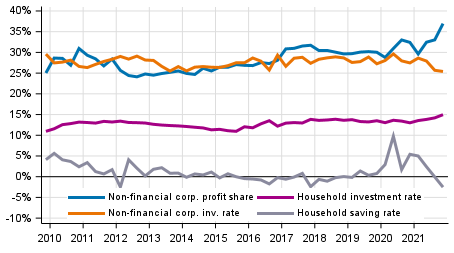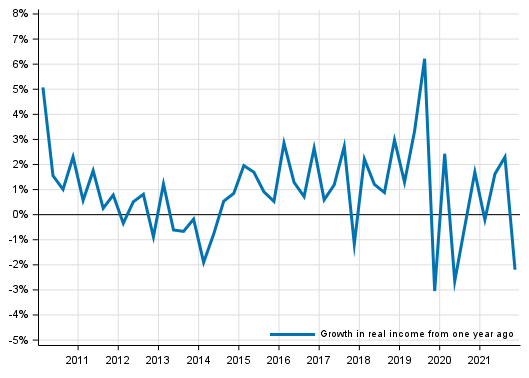Published: 15 March 2022
Households’ saving rate fell in the fourth quarter
Households’ saving rate fell in October to December from the previous quarter. Consumption expenditure grew and disposable income decreased slightly. Households’ investment rate remained on level with the previous quarter. The profit share of non-financial corporations grew by 3.9 percentage points from the previous quarter. The growth in the profit share is caused by the substantial growth in operating surplus. The operating surplus grew strongly because value added grew by 6.7 per cent but compensation of employees paid remained on level with the previous quarter. The investment rate of the non-financial corporations sector was on level with the previous quarter. These data derive from Statistics Finland’s quarterly sector accounts.
Key indicators for households and non-financial corporations, seasonally adjusted

The key figures were calculated from seasonally adjusted time series. Sector accounts are calculated only at current prices. However, an indicator describing the development adjusted for price changes is calculated for households' adjusted disposable income. The profit share, saving rate and investment rate are calculated from net figures, from which consumption of capital is removed. The households sector does not include non-profit institutions serving households.
Households
Households' seasonally adjusted saving rate went down again clearly from the data of the previous quarter and stood at -2.5 per cent in October to December. The saving is derived by deducting consumption expenditure from disposable income. The saving is negative if households' disposable income is lower than households' consumption expenditure. The saving rate refers to the share of households’ savings in disposable income. In the fourth quarter of 2021, households' disposable income decreased, and consumption expenditure grew compared with the previous quarter. The saving turned negative and thus the saving rate decreased clearly compared with the previous quarter.
Households' seasonally adjusted investment rate grew slightly from the previous quarter, being 15.0 per cent. The investment rate is the ratio of households' investments to disposable income. Most of households' investments are investments in dwellings. While households' investments grew slightly, and disposable income decreased, the investment rate grew, although not significantly.
Compared with the corresponding quarter last year, households’ disposable income decreased by around EUR 0.3 billion in the fourth quarter of 2021. The key components of disposable income on the income side are wages and salaries received, entrepreneurial and property income, and social benefits received. The biggest expense items are taxes paid and social contributions. In the fourth quarter of 2021, wages and salaries received increased by EUR 1.2 billion and property income received by an estimated EUR 0.6 billion, entrepreneurial income remained more or less on level with the previous year, and, once the employment situation improved, social security benefits received declined by EUR 0.5 billion compared with the figures of one year ago. On the expense side, taxes paid grew by close on EUR 1.5 billion and social contributions paid by households themselves by around EUR 0.2 billion compared with the corresponding period of the previous year. Social contributions paid by employers are visible for households both as part of compensation of employees received and as part of social contributions paid, and the considerable growth in these figures is mainly due to the temporary lowering of employers' employment pension contributions when the pandemic started, and now the contribution is again at the previous level.
When individual services produced by the public sector and non-profit institutions, such as educational, health and social services, are added to disposable income, the concept of adjusted disposable income can be attained. Adjusted disposable income is the indicator recommended by the OECD for evaluating the economic well-being of households. In the fourth quarter of 2021, households’ adjusted disposable income grew at current prices by 0.8 per cent and adjusted for price changes, it decreased by -2.2 per cent from the corresponding quarter of the year before. The indicator describing the development of adjusted disposable income adjusted for price changes can be found in Appendix table 3 of this publication.
Volume development of households’ adjusted disposable income

Compensation of employees paid by non-profit institutions serving households increased by 4.9 per cent compared with the particularly low quarter of one year ago. The activities of many associations have clearly recovered in the field of sport and culture. The shutdowns started in late 2022 due to the spreading of the omicron variant are not yet visible in these figures.
In these statistics, the households sector only covers the actual households sector S14. Sector S15, non-profit institutions serving households, is calculated and published separately. The households sector in Eurostat’s publications also includes the data for sector S15. Another difference to Eurostat's publication is in how consumption of fixed capital is taken into account. Eurostat publishes investment and saving rates as gross figures, i.e. including consumption of fixed capital. Net data are used in these statistics, that is, when consumption of fixed capital is taken into account, the saving rate decreases, and the investment rate increases.
Non-financial corporations’ profit share grew in the last quarter
In the fourth quarter of 2021, the seasonally adjusted profit share of non-financial corporations grew by 3.9 percentage points to 36.9 per cent. The profit share refers to the share of the operating surplus in value added. The operating surplus is calculated by deducting from value added compensation of employees paid and other taxes on production and by adding to it received subsidies on production. In the last quarter of 2021, the relative growth in value added was clearly faster than the growth in compensation of employees, which increased the operating surplus. No significant changes took place in taxes on products or subsidies on production. In October to December, the level of subsidies on production was still higher than prior to the pandemic.
The investment rate of non-financial corporations, or the proportion of fixed capital investments in value added remained on level with the previous quarter, at 25.4 per cent. Seasonally adjusted investments grew in relative terms more slowly than value added.
Profits of financial and insurance corporations grew
Seasonally adjusted value added in financial and insurance corporations grew by 10.8 per cent from the previous year's corresponding quarter. Output went up by 12.0 per cent and intermediate consumption by 12.9 per cent. The operating surplus describing profits in the sector was EUR 0.7 billion in the last quarter and it grew by 16.6 per cent. Compensation of employees paid, in turn, grew by 8.0 per cent from one year ago.
Property income and property expenditure in the sector grew from the respective quarter of the year before. The property income of financial and insurance corporations grew by 11.3 per cent, or by around EUR 0.3 billion. Property expenditure amounted to 148.9 per cent, or around EUR 3.2 billion more than in the corresponding quarter of the year before. Property items includes dividends, interests and reinvested earnings. The strong growth in property expenditure is particularly caused by the payment of dividends in the banking sector. The prohibition on payment of dividends by banks ended in September and the banks paid unpaid dividends for 2019 and 2020 in October.
Value added and operating surplus describe the income that is generated from providing financial services to the public. It does not include property income or holding gains of securities.
Financial position of general government improved from one year ago
Consolidated total general government revenue grew by EUR four billion, while consolidated total expenditure decreased by EUR 0.5 billion from the previous year's corresponding quarter. The difference between revenue and expenditure, that is, the financial position of general government, was EUR 57 million in deficit.
The statistics on quarterly sector accounts examine general government as a whole. More detailed information on quarterly sector accounts of general government can be found in the statistics on general government revenue and expenditure where the sub-sectors are specified: http://www.stat.fi/til/jtume/index_en.html
International trade increased in the fourth quarter of 2021
The current priced value of exports of goods abroad from Finland amounted to EUR 20.6 billion in the fourth quarter of 2021, which was 23.9 per cent more than in the corresponding quarter one year ago. The value of imports of services was EUR 9.2 billion, which was 17.8 per cent more than one year ago. The value of imports of goods to Finland amounted to EUR 19.7 billion, which was 36.9 per cent more than one year ago. The value of imports of services amounted to EUR 9.0 billion, which was 24.4 per cent more than in the corresponding quarter one year ago. The balance of goods and services showed a surplus of EUR 1.1 billion in the fourth quarter of 2021.
Property income received from abroad was EUR 0.2 billion lower than property income paid abroad. Property income includes dividends, interests and reinvested earnings. Current transfers paid abroad from Finland were EUR 0.8 billion higher than current transfers paid from abroad to Finland. The most significant current transfer item is the GNI payment paid by the state to the EU. The current account was EUR 0.1 billion in surplus in the fourth quarter of 2021.
Data and methods used
The quarterly data become revised as source data are updated. The biggest revisions take place for the last two to three years, because the data in the annual accounts are still preliminary. The data in this publication are based on the data sources available by 2 March 2022. The data for 1999 to 2020 mainly correspond with the annual sector accounts of the National Accounts.
The saving rate, profit share and investment rate in the quarterly publication of sector accounts are net amounts, i.e. consumption of fixed capital has been removed from the figures. In addition, financial accounts data on the stock of households’ loan debts are used in calculating households’ indebtedness rate. The indebtedness rate is presented adjusted and non-adjusted for seasonal variation in the database table of sector accounts. The indebtedness rate from figures non-adjusted for seasonal variation is published by financial accounts. The key indicators in these statistics were calculated as follows:
Households' saving rate = B8N / (B6N+D8R)
Households' investment rate = P51K / (B6N+D8R)
Households' indebtedness rate = F4 / B6N
Profit share of non-financial corporations = B2N / B1NPH
Investment rate of non-financial corporations = P51K / B1NPH
The indicator of households' adjusted disposable income is calculated using the price data of the statistics on quarterly national accounts, with which the components of adjusted disposable income are deflated. Households' disposable income is deflated with the implicit price index of household consumption expenditure. Price data are also available for the consumption of non-profit institutions serving households. As a methodological shortcoming, general government individual consumption expenditure has to be deflated with the total general government consumption expenditure for lack of more accurate data. The volume time series was formed with the annual overlap method.
Source: Sector accounts, Statistics Finland
Inquiries: Nata Kivari 029 551 3361, Katri Soinne 029 551 2778, kansantalous.suhdanteet@stat.fi
Head of Department in charge: Katri Kaaja
Publication in pdf-format (474.7 kB)
- Tables
-
Tables in databases
Pick the data you need into tables, view the data as graphs, or download the data for your use.
Appendix tables
- Figures
- Revisions in these statistics
-
- Revisions in these statistics (15.3.2022)
Updated 15.3.2022
Official Statistics of Finland (OSF):
Quarterly sector accounts [e-publication].
ISSN=2243-4992. 4th quarter 2021. Helsinki: Statistics Finland [referred: 27.7.2024].
Access method: http://www.stat.fi/til/sekn/2021/04/sekn_2021_04_2022-03-15_tie_001_en.html

